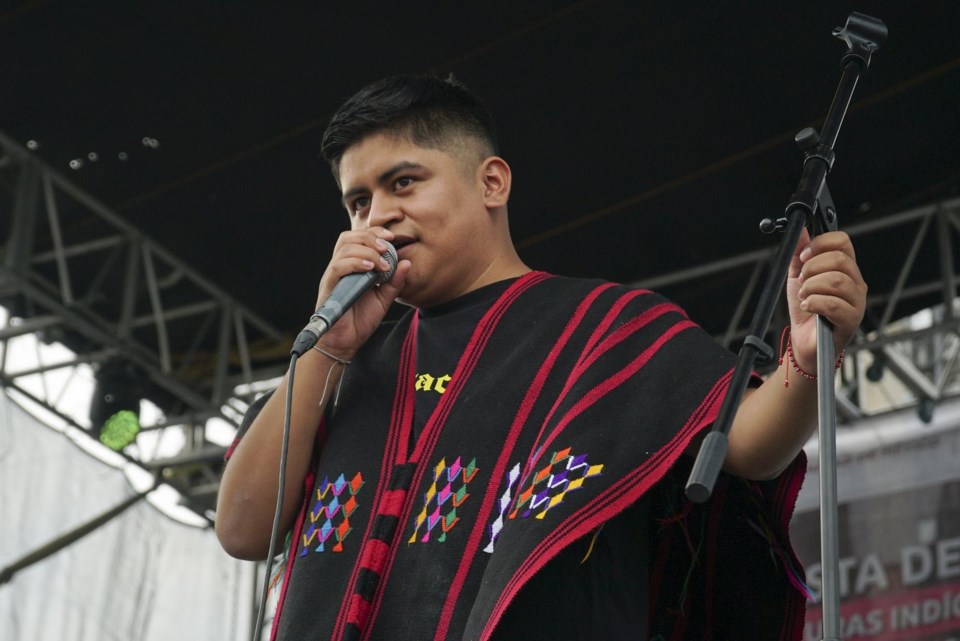MEXICO CITY (AP) — Backstage at a celebration of Indigenous peoples in Mexico City's sprawling central square, Carlos CGH traced his fingers across a black and red “gabán,” which is similar to a poncho.
The garment, native to the Triqui people in western Oaxaca, is a source of pride for the 24-year-old rapper and reserved for special occasions. Its textured surface was decorated with intricate needlepoint patterns of multicolored corn husks.
As the rapper — whose full name is Carlos Guadalupe Hernández — prepared for his performance, Oaxacan muralist Alberto Sebastián Bautista Figueroa brainstormed details. He crafted a drawing with the word “RAICES,” or “ROOTS,” in twisting strokes, for a mural he planned to create during the performance.
“We’re always proud,” Guadalupe later said on stage, wearing the gabán. “This goes out to all craftspeople who are here, people don’t know all the history and all the resistance behind one garment.”
Such details are an important part of his identity as a musician, representing his origins as a descendant of the Triqui nation. His verses are reflective of his culture, and he aims to conserve his native tongue, Triqui, through contemporary rap.
Triqui is one of many Mixtec languages spoken in Oaxaca and has four variants. One variant, Xnánj nu' a, is particular to Guadalupe's hometown of San Juan Copala.
“To my Triqui brothers – farmworkers, students, doctors and all the women,” Guadalupe rapped in Spanish. “We fight every day for a better future.” He held up a shirt that said “Triqui Nation Resists!” while his DJ dropped a series of trap horns.
The Indigenous Triqui people, numbering about 20,000, have struggled with political and social conflicts going back more than 80 years. The area also has become a hot spot for arms trafficking, drug trafficking and illegal logging.
Growing internal disputes for territorial control, including dozens of killings, have led to forced displacement for many in the community.
Many Triquis have moved to Mexico City but push to return to their homes. Guadalupe is originally from the municipality of Santiago Juxtlahuaca, which many Triquis were forced to leave. At the age of 6, he relocated to another Oaxacan city, Huajuapan de LeĂłn, about two hours away.
He got his start in music at age 12 as a percussionist with a local band, surrounded by Oaxaca-Mixteca artists he admired. He started rapping in 2013, inspired by the local scene. "Like love at first sight,” he recalled after seeing local lyricists perform.
He sees rap as a way to conserve his mother tongue.
“It’s a language that is at risk of disappearing. Parents and grandparents are no longer teaching it to their kids,” he said. “We learned that through rap we can make songs that would interest the new generations to speak it (Triqui) again.”
In Oaxaca, the variety of rap is abundant. To mark the , Oaxaca’s Sound Archive, an independent project to demonstrate the state's musical diversity, created a “sonic” map of the region's most influential rappers earlier this year. Carlos CGH was among them.
With about a dozen Indigenous languages, Oaxaca has nurtured a diverse scene. Among Guadalupe's peers are rappers who take pride in rapping in Mixtec, Zapotec, Cuicatec and other languages.
But the scene has suffered from the violence in Oaxaca. Last month, Rosty Bazendu, a passionate lyricist in the Zapotec language, was killed.
“When you look up the Triqui community on the internet, a lot of things are going to come up regarding some of the problems we have,” Guadalupe said. “Here in Mexico City, I come to talk about what’s within my community – the celebrations, the craftsmanship, the children, everyone who has stood out.”
On stage, Guadalupe’s vision of Triqui culture comes to life.
“Where are my people from the Triqui nation?” he shouted. A family in the front row raised their hands.
His last song, dedicated to the people of Santiago Juxtlahuaca, opened with playful arrangements of traditional Oaxacan banda music.
The crowd cheered for “El Baile del Diablo,” or “Devil's Dance,” a traditional dance from the Oaxacan coast. The muralist Bautista exchanged his cans of spray paint for the traditional garb of the devil, wearing a handcrafted wooden mask and stomping across the stage.
Throughout the track, Guadalupe seamlessly wove Spanish verses with Triqui rhymes.
“I will never forget my culture, tradition and language,” he said with pride at the end.
Mariana MartĂnez Barba, The Associated Press




